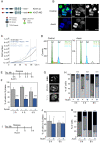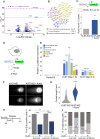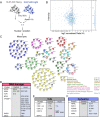Ki-67 is necessary during DNA replication for fork protection and genome stability
- PMID: 38649976
- PMCID: PMC11034166
- DOI: 10.1186/s13059-024-03243-5
Ki-67 is necessary during DNA replication for fork protection and genome stability
Abstract
Background: The proliferation antigen Ki-67 has been widely used in clinical settings for cancer staging for many years, but investigations on its biological functions have lagged. Recently, Ki-67 has been shown to regulate both the composition of the chromosome periphery and chromosome behaviour in mitosis as well as to play a role in heterochromatin organisation and gene transcription. However, how the different roles for Ki-67 across the cell cycle are regulated and coordinated remain poorly understood. The progress towards understanding Ki-67 function have been limited by the tools available to deplete the protein, coupled to its abundance and fluctuation during the cell cycle.
Results: Here, we use a doxycycline-inducible E3 ligase together with an auxin-inducible degron tag to achieve a rapid, acute and homogeneous degradation of Ki-67 in HCT116 cells. This system, coupled with APEX2 proteomics and phospho-proteomics approaches, allows us to show that Ki-67 plays a role during DNA replication. In its absence, DNA replication is severely delayed, the replication machinery is unloaded, causing DNA damage that is not sensed by the canonical pathways and dependent on HUWE1 ligase. This leads to defects in replication and sister chromatids cohesion, but it also triggers an interferon response mediated by the cGAS/STING pathway in all the cell lines tested.
Conclusions: We unveil a new function of Ki-67 in DNA replication and genome maintenance that is independent of its previously known role in mitosis and gene regulation.
Keywords: AID tag; APEX2; DNA damage; DNA replication; HUWE1; Interferon response; Ki-67; Sister chromatid cohesion.
© 2024. The Author(s).
Conflict of interest statement
The authors declare that they have no competing interests.
Figures







Similar articles
-
HUWE1 interacts with PCNA to alleviate replication stress.EMBO Rep. 2016 Jun;17(6):874-86. doi: 10.15252/embr.201541685. Epub 2016 May 4. EMBO Rep. 2016. PMID: 27146073 Free PMC article.
-
E3 ubiquitin ligase Bre1 couples sister chromatid cohesion establishment to DNA replication in Saccharomyces cerevisiae.Elife. 2017 Oct 23;6:e28231. doi: 10.7554/eLife.28231. Elife. 2017. PMID: 29058668 Free PMC article.
-
Destabilization of CDC6 upon DNA damage is dependent on neddylation but independent of Cullin E3 ligases.Int J Biochem Cell Biol. 2013 Jul;45(7):1489-98. doi: 10.1016/j.biocel.2013.04.010. Epub 2013 Apr 15. Int J Biochem Cell Biol. 2013. PMID: 23597704
-
Integrating Sister Chromatid Cohesion Establishment to DNA Replication.Genes (Basel). 2022 Mar 31;13(4):625. doi: 10.3390/genes13040625. Genes (Basel). 2022. PMID: 35456431 Free PMC article. Review.
-
Regulation of sister chromatid cohesion during the mitotic cell cycle.Sci China Life Sci. 2015 Nov;58(11):1089-98. doi: 10.1007/s11427-015-4956-7. Epub 2015 Oct 28. Sci China Life Sci. 2015. PMID: 26511516 Review.
Cited by
-
Ki-67 and CDK1 control the dynamic association of nuclear lipids with mitotic chromosomes.J Lipid Res. 2025 Jan;66(1):100731. doi: 10.1016/j.jlr.2024.100731. Epub 2024 Dec 18. J Lipid Res. 2025. PMID: 39706365 Free PMC article.
-
Current advances in cancer immunohistochemistry: a new perspective for the Ki-67 biomarker.Ecancermedicalscience. 2025 Mar 5;19:1863. doi: 10.3332/ecancer.2025.1863. eCollection 2025. Ecancermedicalscience. 2025. PMID: 40492213 Free PMC article. Review.
-
The impact of stratified management of Ki-67 on the prognosis of small-cell lung cancer.BMC Cancer. 2025 Jul 21;25(1):1197. doi: 10.1186/s12885-025-14445-w. BMC Cancer. 2025. PMID: 40691591 Free PMC article.
-
The mitotic chromosome periphery modulates chromosome mechanics.Nat Commun. 2025 Jul 10;16(1):6399. doi: 10.1038/s41467-025-61755-5. Nat Commun. 2025. PMID: 40640170 Free PMC article.
-
Basophil-derived exosomes exacerbate systemic lupus erythematosus by regulating B-cell proliferation via miR-24550.BMC Med. 2025 Aug 22;23(1):490. doi: 10.1186/s12916-025-04324-3. BMC Med. 2025. PMID: 40846943 Free PMC article.
References
-
- Dowsett M, Nielsen TO, A'Hern R, Bartlett J, Coombes RC, Cuzick J, Ellis M, Henry NL, Hugh JC, Lively T, et al. Assessment of Ki67 in breast cancer: recommendations from the International Ki67 in Breast Cancer working group. J Natl Cancer Inst. 2011;103:1656–1664. doi: 10.1093/jnci/djr393. - DOI - PMC - PubMed
-
- Duregon E, Bertero L, Pittaro A, Soffietti R, Ruda R, Trevisan M, Papotti M, Ventura L, Senetta R, Cassoni P. Ki-67 proliferation index but not mitotic thresholds integrates the molecular prognostic stratification of lower grade gliomas. Oncotarget. 2016;7:21190–21198. doi: 10.18632/oncotarget.8498. - DOI - PMC - PubMed
Publication types
MeSH terms
Substances
Grants and funding
LinkOut - more resources
Full Text Sources
Research Materials
Miscellaneous

